Simulation Study of Network Reconfiguration and Load-balancing Method for the Xinjiang Astronomical Observatory Data Center
Jie Wang,Hailong Zhang,Na Wang,Xinchen Ye,Wanqiong Wang,Jia Li,Meng Zhang,2,Yazhou Zhang,2,and Xu Du,2
1 Xinjiang Astronomical Observatory, Chinese Academy of Sciences, Urumqi 830011, China; zhanghailong@xao.ac.cn
2 University of Chinese Academy of Sciences, Beijing 100049, China
3 National Astronomical Data Center, Beijing 100101, China
4 Key Laboratory of Radio Astronomy, Chinese Academy of Sciences, Nanjing 210008, China
Abstract The Xinjiang Astronomical Observatory Data Center faces issues related to delay-affected services. As a result, these services cannot be implemented in a timely manner due to the overloading of transmission links. In this paper, the software-defined network technology is applied to the Xinjiang Astronomical Observatory Data Center Network(XAODCN).Specifically,a novel reconfiguration method is proposed to realise the software-defined Xinjiang Astronomical Observatory Data Center Network(SDXAO-DCN),and a network model is constructed.To overcome the congestion problem, a traffic load-balancing algorithm is designed for fast transmission of the service traffic by combining three factors:network structure,congestion level and transmission service.The proposed algorithm is compared with current commonly load-balancing algorithms which are used in data center to verify its efficiency.Simulation experiments show that the algorithm improved transmission performance and transmission quality for the SDXAO-DCN.
Key words: virtual observatory tools – astronomical databases: miscellaneous – methods: miscellaneous
1. Introduction
The Xinjiang Astronomical Observatory Data Center (XAODC)(Zhang et al.2019)commenced operating from 2015,and has effectively solved the problem of archiving and retrieving the valuable astronomical data accumulated by the Nanshan 26-m radio telescope (NSRT) and the Nanshan one-meter wide-field telescope (NOWT) over several years of observation. It has also provided open sharing of the astronomical observation data to the public. Based on the latest virtual observatory (VO) standards, a number of data services have been released to the public.The basic services include the following:data storage,data management and release for astronomical observations;long-term storage and access services for valuable astronomical data and secondary processed data; scientific data archive and release, and related technical support for researchers. The data resources mainly include NSRT pulsar observations, active galactic nuclei observations, molecular spectral line observations and NOWT observations. The data services provided include PPMXL catalog cone search, online cross-certification of massive catalog data, and UCD information query.With the continuous improvement in the NSRT and NOWT observation capabilities, the demand for differentiated services provided by the XAO-DC has been increasing.Bandwidth-affected services, such as astronomical data storage and backup, lead to network congestion due to the overloading of some transmission links,resulting in delay-affected services(such as astronomical data retrieval),which cannot be implemented in a timely manner.In this work,a software-defined networks(SDN)technology reconfiguration method is applied to an astronomical data center network(DCN). There are three reasons for using SDN: (1) it has the advantage of centralised control, comprehensive control of the network state and network programmable; (2) it shifts the intelligence of the network from hardware to software, adding new features to the network without updating hardware devices;(3)the performance of the astronomical data center transmission networks can be improved while avoiding conflicts between astronomical service flows and ensuring network load-balancing.As a result,the problems related to transmission network stability,scalability and bandwidth bottleneck can be effectively overcome by reducing the deployment cost while avoiding conflicts between astronomical service flows, ensuring network load-balancing and effectively solving problems of transmission network stability,scalability and bandwidth bottlenecks.
2. Xinjiang Astronomical Observatory Data Center Network Architecture and Traffic Characteristics
2.1. Network Architecture
A DCN is the basic infrastructure of an astronomical data center and is responsible for transmitting various core key services, including data storage and archiving as well as facilitating networked scientific research. Such a network can be implemented using three types of structure:(1)a server-based network represented by the BCube structure proposed by Guo et al. (2009), the CamCube structure proposed by Abu-Libdeh et al. (2010) and the MDCube structure proposed by Wu et al.(2009); (2) a switch-based network represented by the fat-tree architecture (Al-Fares et al. 2008), the optical switching architecture proposed by Kai et al. (2014) and the virtual layer 2(VL2)architecture proposed by Greenberg et al.(2011);(3)the irregular network with no uniform structure. The XAO-DC adopts a two-layer tree structure with the core switch as the root node.This network structure is simple and intuitive to build and manage as well as easy to operate.However, its performance is affected by the bandwidth of the root node and exhibits disadvantages such as low overall network utilisation and extended data transmission time.Also,a failure in the root node will cause a single-point failure. As NSRT and NOWT observations have been increasing,new requirements have been put forward regarding the performance of the XAO-DC.
2.2. Flow Characteristics
Significant research work has been conducted on DCN traffic characteristics. Benson et al. (2010) studied ten data centers and found that the number of large data streams in DCNs,although less than 10% of the total traffic, accounts for 80% of the total bandwidth. They also found that the rest belongs to small data streams, which account for 90% of the total traffic with less than 10 MB(more than 80%of the data streams bytes are less than 10 KB).Kandula et al. (2009) found that more than 80%of the data streams in DCNs have a duration less than 10 s and no more than 0.1% of the total data streams have a duration greater than 200 s.The XAO-DC network is required not only to complete the storage and backup of NSRT and NOWT observation data but also to interact with researchers, complete the response and processing of external requests and provide efficient data access and interoperability to researchers to retrieve and analyze the data in a Web or VO manner.In addition,based on the access and interoperability of astronomical data, the astronomical data center is also required to perform computational and analytical tasks to identify new patterns and discoveries from the huge amount of data obtained.These data and various application requirements make the traffic in the XAODC exhibit different characteristics. The XAO-DC operates two types of traffic: one is the astronomical service traffic affected by the bandwidth(this type of traffic is mainly generated by processes such as NSRT and NOWT data storage and backup, which have high-bandwidth requirements);the other is the astronomical service traffic affected by the delay(this type of traffic is mainly generated by processes such as high-performance computing and astronomical data retrieval, which have low-delay requirements. Between them, the bandwidth-affected astronomical service traffic occupies most of the bandwidth with a certain imbalance, and the local traffic bursts lead to a long-tailed distribution of statistical characteristics.These data flows collide with each other and affect each other in the following way: the bandwidth-affected astronomical service traffic affects the transmission of the delayaffected astronomical service traffic, resulting in a significant increase in the delay and packet loss;a large amount of the delayaffected astronomical service traffic affects the transmission of the bandwidth-affected astronomical service traffic, resulting in reduced network throughput and poor network performance.
3. Mathematical Modelling
3.1. Network Model
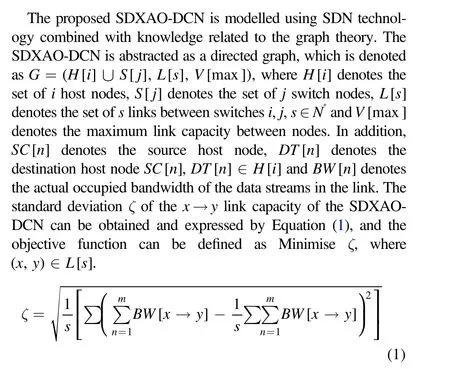
According to the flow conservation law in the transmission of astronomical data center traffic,the outflow of any flow from the source host nodeSC[n]is equal to the inflow into the destination host nodeDT[n], expressed by Equations (2) and(3) wherey,SC[n],DT[n] ∈L[s]
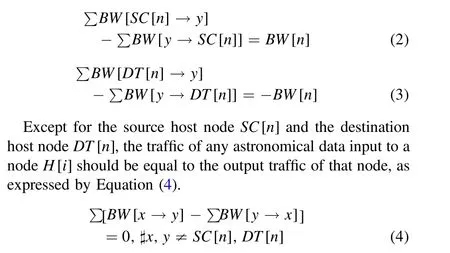
The bandwidth condition shown in Equation (5) must be satisfied during the scheduling of the astronomical data transmission traffic, and the requested bandwidth of the traffic in each link must satisfy non-negativity, as expressed by Equation (6).
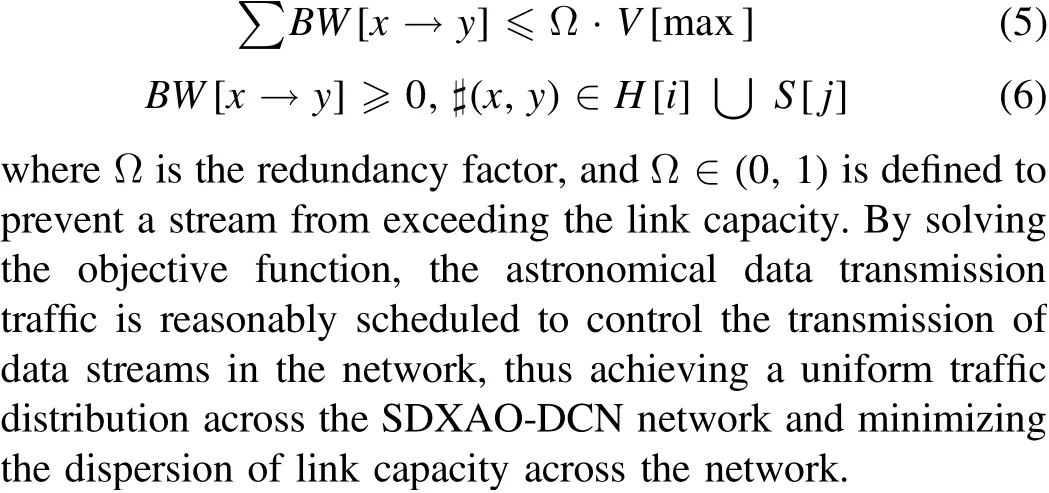
3.2. Load-balancing Modelling


4. Network Module and Load-balancing Algorithm Design
As shown in Figure 1, based on the SDN technology and the OpenFlow protocol,the following functional modules are designed for the SDXAO-DCN,according to the transmission requirements of the astronomical data center:global topology discovery module,global status awareness module, traffic detection module, route calculation module and policy deployment and distribution module.
4.1. Global Topology Discovery Module
In the global topology discovery module,the controller sends packets to the switches in the SDXAO-DCN transport network through the link layer discovery protocol(LLDP)via Packet_out messages,and the switches flood the received LLDP packets to all ports. When other neighboring switches receive an LLDP packet and find that there is no flow table entry in the switch flow table that matches the received packet, the switch sends a PACKET_IN message to the controller. After receiving the PACKET_IN message,the controller parses the packet and logs the topology information to obtain the entire network topology.
4.2. Global Status-awareness Module
The global status-awareness module sends relevant state request messages to the SDN switch by periodically calling the port state request method and the stream state request method.For example,the SDN controller periodically sends the OFP_PORT_-STATS_REQUEST message to the SDN switch, and the SDN switch replies with the OFP_PORT_STATS_REPLY message to the SDN controller. The SDN controller parses the message body to obtain port information, including packets, bytes and timestamps of the receiving and sending ends.It then obtains the link state information and data flow statistics of the SDN switch and passes this link-state information to the route calculation module and the data flow information to the astronomical large data flow detection module.
4.3. Traffic Detection Module

Figure 1. SDXAO-DCN functional module design diagram.
Based on the data flow information collected by the global status-awareness module, the traffic flowing through the SDN switch is periodically detected for congestion and service type determination. The traffic matrix is adjusted using the OFPT_PACKET_IN and OFPT_FLOW_REMOVE messages to assign the detected traffic to the path that provides sufficient link space;this path is stored in the memory.Each storage object is identified by a sequence number, which is incremented by 1 after each interval.It is important to note that at any given moment,only the two most recent storage objects are stored in the memory. The other components of the SDN controller can directly access the current storage object in the memory to obtain the required information.
4.4. Routing Calculation Module
The routing calculation module,which is the core module of the SDXAO-DCN,routes the data folw according to the determination result of the traffci detection module, whose key is the loadbalancing algorithm.The specifci implementation process is shown in Figure 2. When the standard deviation of the link capacity DIST[t] <0.1, the transmission path has no congestion or very low congestion and the shortest path can be calculated using the Dijkstra algorithm to complete the traffci forwarding. When the standard deviation of the link capacity DIST [t]≥0.1, the transmission path is congested and the type of transmission traffci is detected. If the service traffci is affected by the bandwidth, the SDN controller controls the transmission; if the service traffic is affected by the delay, the default equivalent multipath ECMP(Hopps 2000) routing method is used for transmission.
4.5. Policy Deployment Distribution Module
The routing information calculated by the route calculation module is sent down to the SDN switch in the astronomical data center in the form of a flow table by the policy deployment distribution module. The flow table entries are updated in the SDN switch to match the new flow table entries, and the packets are forwarded when the astronomical data flow enters the SDN switch. In this way, the data transmission process is completed.
5. Simulation Analysis
5.1. Simulation Environment

Figure 2. Load-balancing algorithm.
An Intel(R) Xeon(R) W-2145 CPU @ 3.70 GHz workstation with 64 GB of memory was used for the simulation experiments.Two sets of virtual machines (VMs) were built by deploying the operating system Ubuntu 18.04.1 (a Linux version 5.3.0-46-generic).One set of VMs employed the RYU6https://ryu.readthedocs.io/en/latest/index.htmlSDN controller to implement the prototype astronomical data-traffic scheduling algorithm in the SDXAO-DCN. In the other set of VMs, the lightweight network simulator Mininet(Lantz et al.2010)(version:2.2.2) was installed to emulate the network environment of SDXAO-DCN and simulate multiple hosts, switches and other multiple links on the Linux kernel. The switch was the Open vSwitch 2.5.5, the southbound interface protocol was the Open-Flow 1.3, the network traffic required for the experiment wasgenerated using the Iperf traffic generation tool,and the bandwidth monitoring tool used was the Bandwidth Monitor NG (bwm-ng)v0.6.1. The simulation parameters are shown in Table 1, it is important to note that choosing a larger bandwidth will affect the performance of the Mininet, so the bandwidth has been scaled down equally and set at 10/100 Mbps for the experiment. The efficiency and performance evaluation of the astronomical datatraffic scheduling is not affected,and the impact of the simulation platform performance limitations on the results is also reduced.The flow model settings are shown in Table 2, the random flow model simulates general conditions and the restricted traffic model simulates flow conditions for specific data transmission services.

Table 1 Simulation Experiment Parameters
5.2. Performance Analysis
To verify the superior performance of the proposed algorithm, an experimental comparison of three algorithms was conducted. Algorithm 1 is the ECMP algorithm, which is widely used in current data centers. ECMP is a flow-based static load-balancing algorithm capable of significantly improving the network throughput.However,it is unable to adjust the transmission weight of data flow according to specific data flow variations in the network and is prone to network congestion.Algorithm 2 is the Hedera algorithm (Al-Fares et al. 2010).This is a dynamic traffic-scheduling algorithm based on the global first fit (GFF). This algorithm performs a linear search for all valid transmission paths and assigns them on demand while updating the link state and waiting for the next search.Algorithm 3 is the algorithm proposed in this paper. To verify the scalability of the proposed algorithm,Topology-I was set as a small-scale network,consisting of 20 switches,16 servers and 48 links,whereas Topology-II was set as a large-scale network,consisting of 45 switches, 54 servers and 144 links. By conducting simulation experiments, a comparison of the three algorithms was conducted regarding the throughput and latency. The comparison results are presented below.
5.2.1. Throughput Test Results
Throughput portrays the maximum end-to-end rate in packet transmission and is an important metric for evaluating network performance.In the throughput experiment,five groups of trafficmodels were employed to evaluate each of the three algorithms described above. Because the total bandwidths of Topology-I and Topology-II are different, to facilitate the comparison,the bandwidths were normalized using Equation (9). The bandwidths recorded in the experiments were mapped to the[0, 1] interval,as shown in Figure 3,where a simple comparison of the average throughputs within 60 s of random sampling is presented.

Table 2 Flow Model Settings

Because the simulation experiments and the real network environment are both affected by various factors, to verify the universality of the proposed algorithm,100 groups of experiments conducted in different periods(between 2021 December and 2022 February)were selected for comparison.The results are shown in Figure 3.The results obtained by employing five traffic models in Topology-I indicate that the average throughputs are approximately 19.98%, 30.39% and 60.80% for Algorithms 1, 2 and 3,respectively. Clearly, Algorithm 3 exhibits the best performance.The results obtained by employing five traffic models in Topology-II indicate that the overall trend of the three algorithms is largely unchanged. Specifically, the average throughputs are approximately 20.04%, 26.44% and 63.98% for Algorithms 1, 2 and 3, respectively. Again, Algorithm 3 exhibits the best performance. For the traffic models Flow 4 and Flow 5 in Topology-I, the algorithm performance improvement is not obvious because the dif_Pod traffic accounts for a small percentage of the service traffic affected by the bandwidth; thus,the algorithm-scheduling effect is not obvious.
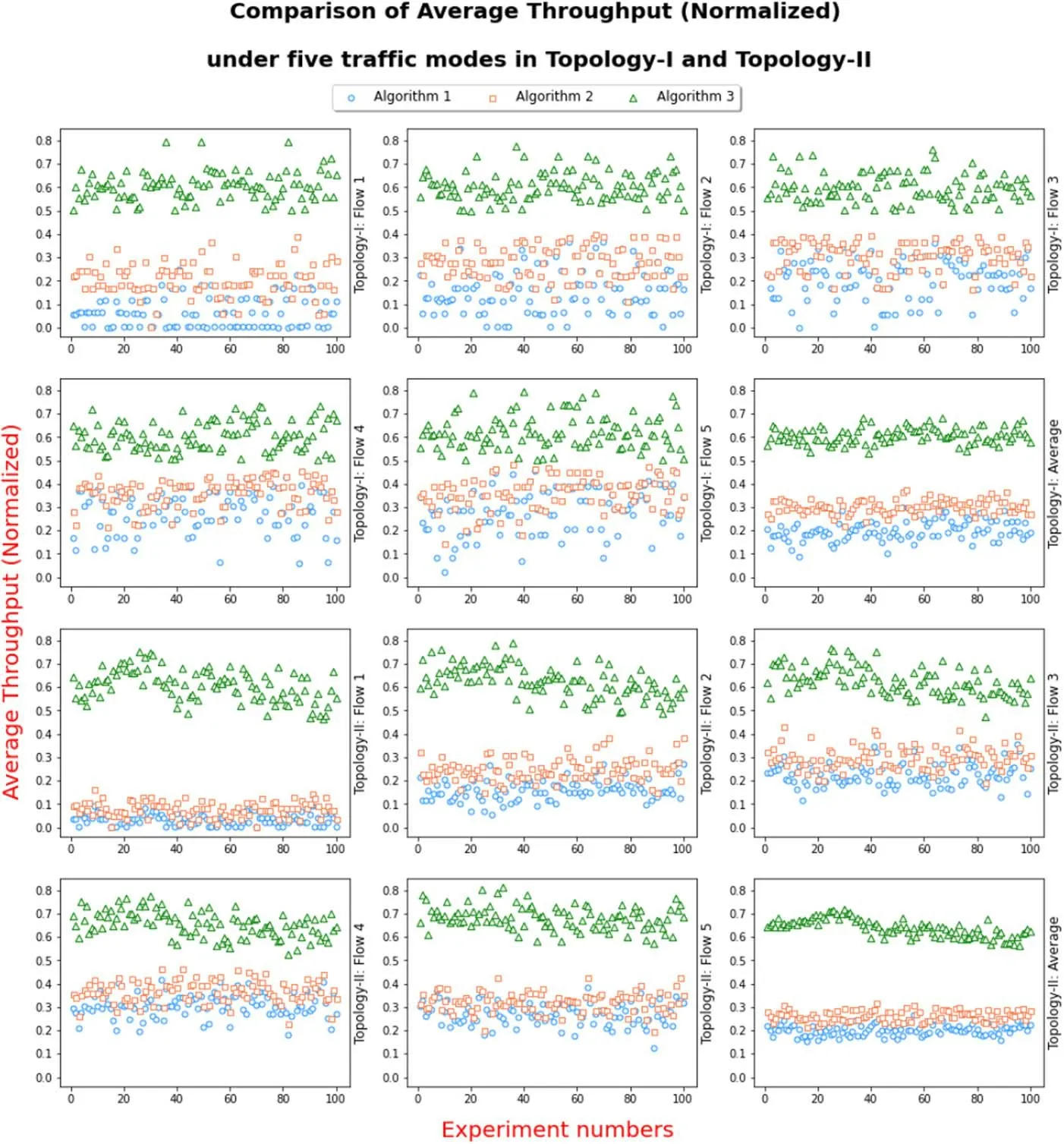
Figure 3. Comparison of 100 normalized average throughputs for three scheduling algorithms.
The low performance of Algorithm 1 is due to the lack of differentiation between the bandwidth-affected and latencyaffected traffic, where all traffic streams are mixed together and collide with each other, creating congestion in some links and preventing the traffic behind them from being transmitted. The links still generate congestion.Algorithm 3 first assesses the global state of the link and directly assigns the shortest path for transmission in the case of no congestion. It also performs loadbalancing on those links,where congestion is detected.The service traffic affected by the bandwidth is calculated by the SDN controller and forwarded to the path, whereas the service traffic affected by the delay is forwarded by the ECMP algorithm,which improves the traffic forwarding efficiency. A comparison of the mean and standard throughput variance for the five traffic patterns employed is shown in Figure 4.The mean standard deviations in Topology-I are 0.1206, 0.0876 and 0.0629 for Algorithms 1, 2 and 3,respectively.In Topology-II,the mean standard deviations are 0.1068, 0.1093 and 0.0653 for Algorithms 1, 2 and 3,respectively. The results indicate that Algorithm 3 exhibits the lowest dispersion and, correspondingly, the lowest load.
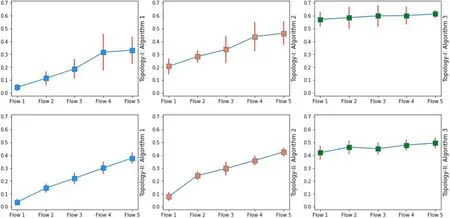
Figure 4. Comparison of mean and standard throughput variance for three scheduling algorithms.
From the above experiments,it is verified that Algorithm 3 can effectively improve the throughput of the SDXAO-DCN by providing discrete available transmission paths for bandwidthaffected services.
5.2.2. Round-trip Delay Test Results
The round-trip delay is the total delay experienced from the time a transmitter sends data to the time it receives an acknowledgment from the receiver. It is affected (to some extent) by the link propagation time, the system processing time as well as the queuing and processing time in the cache of the switching equipment, which reflects the network congestion degree of variation. Experiments were conducted using five traffic model groups,and a total of 100 tests were conducted to evaluate the three algorithms separately.To facilitate the comparison,the round-trip delay was normalized using Equation(10),and the experimentally recorded round-trip delay was mapped to the[0, 1] interval, as shown in Figure 5, where a comparison of the 100 normalized average round-trip delays for the three algorithms is presented.

The test results of the five traffic models employed in Topology-I indicate that the average round-trip delays are 37.51%, 21.44% and 1.17% for Algorithms 1, 2 and 3,respectively. It is clear that the average round-trip delay of Algorithm 3 is significantly lower than that of the other two algorithms.The test results of the five traffic models employed in Topology-II indicate that the average round-trip delays are 54.58%, 18.54% and 3.84% for Algorithms 1, 2 and 3,respectively. It is clear that the average round-trip delay of Algorithm 3 is significantly lower than that of Algorithm 1.This is because Algorithm 1 simply distributes the traffic to each transmission path equally,which generates congestion due to the collision of traffic streams randomly selected for the same path,resulting in the delay-affected traffic at the back of the queue not being transmitted.
A comparison of the mean and standard variance of the round-trip time delay for the five traffic patterns is shown in Figure 6.The mean standard deviations of the three algorithms in Topology-I are 0.1756,0.1369 and 0.0092 for Algorithms 1,2 and 3, respectively. In Topology-II, the mean standard deviations are 0.2290, 0.1003 and 0.0225, respectively. These results indicate that Algorithm 3 exhibits the lowest round-trip time and stable performance.
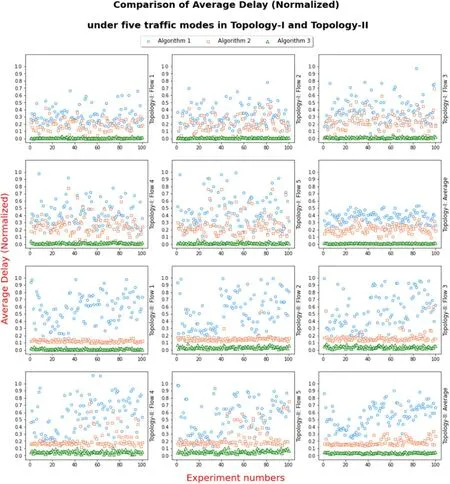
Figure 5. Comparison of 100 normalized, average round-trip delays for three scheduling algorithms.
From the above experiments, it is verified that Algorithm 3 can effectively reduce the round-trip delay of the SDXAODCN by providing a fast transmission path for delay-affected services, which effectively reduces the response time.
6. Conclusions

Figure 6. Comparison of the mean and standard variance of round-trip time delay for three scheduling algorithms.
In this paper, based on the differentiated demand for transmission services of the Xinjiang Astronomical Observatory Data Center Network, a novel software-defined reconfiguration method for this observatory was proposed,and the objective function and constraints were presented.The data flow in the network is controlled by reasonably scheduling the astronomical data transmission traffic through the objective function solution. Then, the SDXAO-DCN can be realised. The uniform distribution of the traffic across the network minimizes the dispersion of link capacity across the network. For the congestion problem of the transmission network, mathematical modeling was performed and loadbalancing algorithms based on influencing factors were designed to realise the classification and scheduling of two transmission services affected by the bandwidth and delay.The simulation results verified that the designed algorithm achieves better data transmission performance compared with the current load-balancing algorithms commonly used in data centers.
Acknowledgments
This work is supported by National Key R&D Program of China No. 2021YFC2203502, the National Natural Science Foundation of China (NSFC) (11803080, 12173077,11873082, and 12003062), the Tianshan Innovation Team Plan of Xinjiang Uygur Autonomous Region (2022D14020),the Youth Innovation Promotion Association CAS, and National Key R&D Program of China No. 2018YFA0404704.
ORCID iDs
Xu Du https://orcid.org/0000-0001-6448-0822
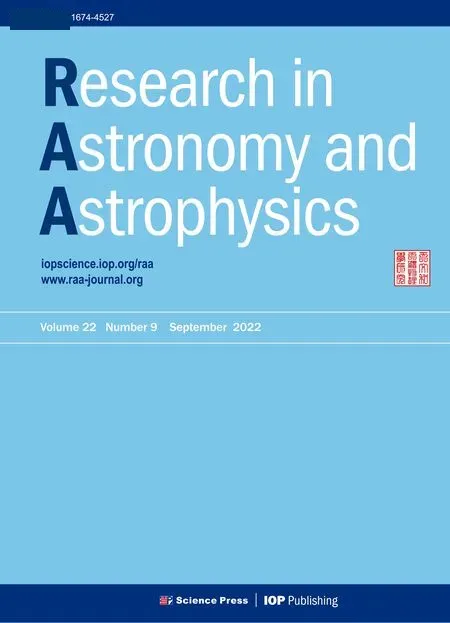 Research in Astronomy and Astrophysics2022年9期
Research in Astronomy and Astrophysics2022年9期
- Research in Astronomy and Astrophysics的其它文章
- The Quasar Candidate Catalogs of DESI Legacy Imaging Survey Data Release 9
- A Photometric Study of Two Contact Binaries:CRTS J025408.1+265957 and CRTS J012111.1+272933
- Investigating the UV-excess in Star Clusters with N-body Simulations:Predictions for Future CSST Observations*
- A Catalog of Molecular Clumps and Cores with Infall Signatures
- Detection of 16 Small Glitches in Nine Pulsars
- Investigations of Thermal Deformation Based on the Monitoring System of Tianma 13.2m VGOS Telescope
